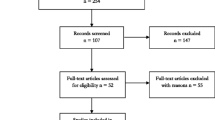Abstract
Closed suction drainage systems are commonly used in orthopaedic surgery, particularly in joint arthroplasty. The rationale for the use of drains is a theoretical reduction of wound haematomas and infection. However the benefit of using drains after total hip or knee arthroplasty is controversial. Several reports have shown that the use of drains does not reduce infection and morbidity and is an unnecessary and potentially dangerous practice. In fact most studies highlighted that at best their use appears to make no difference to important clinical outcomes. Recently a metaanalysis raised the question about the usefulness of closed suction drainage again, concluding that it has no major benefits. The purpose of this study was to review the evidences available concerning the utility of closed suction drainage outlining that this practice is not supported by clinical evidence.
Similar content being viewed by others
Author information
Authors and Affiliations
Corresponding author
Rights and permissions
About this article
Cite this article
Tucci, G., Amorese, V. & Romanini, E. Closed suction drainage after orthopaedic surgery: evidence versus practice. J Orthopaed Traumatol 7, 29–32 (2006). https://doi.org/10.1007/s10195-006-0118-9
Received:
Accepted:
Issue Date:
DOI: https://doi.org/10.1007/s10195-006-0118-9




